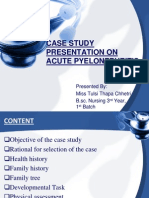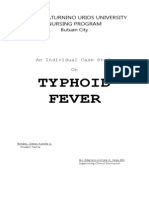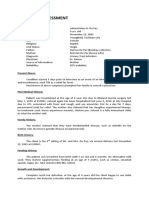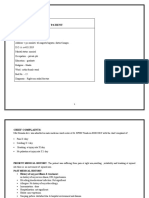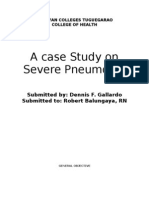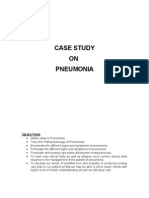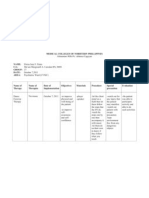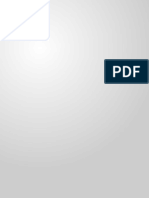Case Presentation On Urinary Tract Infection
Case Presentation On Urinary Tract Infection
Uploaded by
John Alvin YoroCopyright:
Available Formats
Case Presentation On Urinary Tract Infection
Case Presentation On Urinary Tract Infection
Uploaded by
John Alvin YoroOriginal Title
Copyright
Available Formats
Share this document
Did you find this document useful?
Is this content inappropriate?
Copyright:
Available Formats
Case Presentation On Urinary Tract Infection
Case Presentation On Urinary Tract Infection
Uploaded by
John Alvin YoroCopyright:
Available Formats
MEDICAL COLLEGES OF NORTHERN PHILIPPINES
A
CASE PRESENTATION
ON
URINARY TRACT INFECTION
PRESENTED BY:
BORJA, OLIVIA
PADUA, BETALY JANE
VERDADERO, CRIZEL JOY B.
YANGAT, MADONNA ROSE A.
YANOS, MARIENET
YORO, JOHN ALVIN U.
YUMUL, MARCHELLE A.
YUMUL, MAYRITZ GALE A.
ZAMBRA, JEREMY C.
PRESENTED TO:
MR. RICHARD DIZON, RN,MSN
A Case Presentation on UTI Page 1
MEDICAL COLLEGES OF NORTHERN PHILIPPINES
INTRODUCTION:
A urinary tract infection (UTI) is a common type of infection that occurs in the urinary tract
which includes the kidneys, the ureters, the bladder and the urethra. The symptoms of a UTI include
pain or a burning sensation during urination (dysuria), a frequent need to urinate, and lower
abdominal pain.
Normally, urine is sterile. It is usually free of bacteria, viruses, and fungi but does contain fluids,
salts, and waste products. An infection occurs when tiny organisms, usually bacteria from the digestive
tract, cling to the opening of the urethra and begin to multiply. The urethra is the tube that carries
urine from the bladder to outside the body. Most infections arise from one type of bacteria,
Escherichia coli (E. coli), which normally lives in the colon. Any abnormality of the urinary tract that
obstructs the flow of urine (a kidney stone, for example) sets the stage for an infection. An enlarged
prostate gland also can slow the flow of urine, thus raising the risk of infection. People with diabetes
have a higher risk of a UTI because of changes in the immune system. Any other disorder that
suppresses the immune system raises the risk of a urinary infection.
The infection is usually mild and usually resolves within four to five days. Antibiotics can be
used to help speed up the recovery time. However, some patients find that they experience repeated
UTIs, and that they require long-term treatment with antibiotics to prevent the infection returning.
Complications of a UTI are uncommon, but serious, and include kidney failure, where the
kidneys lose almost all of their functioning capability and blood poisoning, also known as sepsis These
complications usually only affect people with a pre-existing health problem, such as diabetes because
of the changes in immune system, and weakened immune system (the body’s natural defence against
infection).
UTIs are a very common type of infection particularly in women. It is estimated in the
Philippines that one woman in three will have a UTI before the age of 24, and that half of all women
will have at least one UTI during their lifetime. This is less common in men. It is estimated that every
year in the Philippines, in otherwise healthy men, only one in every 2,000 will develop a UTI.
This case presentation is done to increase our awareness with regards to infections affecting
the urinary system. This is to widen our knowledge and to have a strong background about urinary
tract infection. This case presentation will definitely help us in future purposes; this will be our
foundation when we encounter such in the field we’ve chosen.
A Case Presentation on UTI Page 2
MEDICAL COLLEGES OF NORTHERN PHILIPPINES
OBJECTIVES:
General Objectives:
This case presentation was designed to develop a holistic and patient centered nursing care and
responsibilities. This is to broaden the knowledge of the presenters as well as the audience with
regards to Urinary Tract Infection; this is also designed to enhance skills and attitudes in the
application of nursing process and management of the disease.
Specific Objectives:
-For the participants/critics, for us presenters, for the patient & significant others to have a
better understanding on the disease process.
-To identify the factors (predisposing, precipitating or etiologic agent if any) that causes the
disease.
-To identify the sign and symptoms manifested by the patient with Urinary Tract Infection and
perform further assessment to be able to recognize appropriate nursing intervention to be
rendered.
-Discuss the anatomy and physiology and how it is being altered the disease process.
-To have the pathophysiology and to trace the occurrence of Urinary Tract Infection.
-To utilize properly the nursing process (assessment, diagnosis, planning, intervention,
evaluation) as the framework for the care of the patient.
-To select appropriate nursing diagnosis for the patient with UTI based on assessment findings.
-To learn various medications, it’s condition, adverse effects & accompanying nursing
responsibilities.
-To put into action what we have learned in the school (such as nursing process) and apply our
knowledge in providing quality and individualized nursing care.
-To enhance group’s attitude, like discipline, cooperation, leadership abilities and teamwork in
making and presenting a case presentation.
-To involve the patient’s family in the implementation of nursing management throughout
hospital experienced.
A Case Presentation on UTI Page 3
MEDICAL COLLEGES OF NORTHERN PHILIPPINES
PATIENT’S PROFILE:
NAME: Mr. AB
AGE: 38 years old
BIRTHDAY: April 9, 1972
SEX: Male
PLACE OF BIRTH: Minanga Norte, San Pablo Isabela
CIVIL STATUS: Married
NATIONALITY: Filipino
DIALECT: Ilocano, Ibanag
RELIGION: Roman Catholic
ADDRESS: Barangay Tallag San Pablo Isabela
OCCUPATION: Carpenter
EDUCATIONAL ATTAINMENT: High School Graduate
DATE OF ADMISSION: August 2, 2010
TIME OF ADMISSION: 2:55 pm
MODE OF ARRIVAL: Ambulatory
CHIEF COMPLAINT: Chills and Fever
SOURCE OF INFORMATION: Patient, Significant other and patient’s chart
ADMITTING DIAGNOSIS: Urinary Tract Infection
ATTENDING PHYSICIAN: Dr. Vilma Lorenzo
DATE and TIME INTERVIEW: August 2, 2010 @ 4:35 pm
A Case Presentation on UTI Page 4
MEDICAL COLLEGES OF NORTHERN PHILIPPINES
GORDON’S 11 FUNCTIONAL PATTERNS:
1. HEALTH PERCEPTION-HEALTH MANAGEMENT PATTERN
Before hospitalization:
Mr. AB’s description about his health is a situation wherein he can do tasks and activities
without hindrances in his physical, mental, emotional, social and spiritual living. He rates his
health 8 on a health scale, 10 as the highest and 1 as the lowest. Every time he feels bad about
his health, he increases his fluid intake, he rests and he sleeps as management. According to
him, he seeks medical advice whenever he feels something bad in his health. But at times, he
seeks for the assistance of albolaryos. One thing that proves that he seeks albolaryos is his hair
being cut in the upper part of his head, according to him, the albolaryo sucked little amount of
blood in that site using the horn of a carabao. It is believed that this process can clean the blood
of the individual/costumer.
During hospitalization:
The client said that it seems he is imprisoned and manacled with the consequences of
being unhealthy that he cannot function well and cannot longer perform his ADL’s due to his
present condition. He describes his current health problem as something which down casted
him from the normal ways of running his life which made him rate his health status as 5 in the
above mentioned health scale. Though at some intonations of his voice, he wants to insist that
he’s okay.
2. NUTRITION-METABOLIC PATTERN
Before hospitalization:
The patient weighs 62 kilograms and he has a height of 5’7”. He eats three times a day
with 2-time snacks, in the morning at around 9am and in the afternoon at around 3pm.
According to him he eats foods that are being prepared; he is not choosy in terms of eating but
their usual menu according to his SO are vegetables. He made verbalized that he takes soft
drinks or juices twice a day, included to these is water. In a day, he takes approximately 4 litres
of water. According to him, he don’t take any supplemental vitamins
During hospitalization:
The patient said that he doesn’t have the appetite to eat, but, still his drinking habits
and behaviours don’t changed. According to him, though he has loss of appetite, he still needs
to eat. He needs to follow the diet given by the attending physician which is DAT and he eats
foods given by the hospital.
3. ELIMINATION PATTERN
Before hospitalization:
Mr. AB did not specified how many times a day he urinates but he made mentioned that
he urinates frequently a day which measures approximately ½ cup every urination. His urine is
yellow amber in colour. He mentioned that whenever he feels that he wants to urinate, he tries
to stop that feeling and finish first what he is doing before urinating. One week prior to
hospitalization, he feels a little/slight pain during urination, the pain according to him was in the
4th level of the pain scale, 10 as the highest and 1 as the lowest. He defecates 1-2 times a day
with brown stool. He doesn’t use enemas and suppositories. He feels no discomfort during
defecation.
A Case Presentation on UTI Page 5
MEDICAL COLLEGES OF NORTHERN PHILIPPINES
During hospitalization:
He urinates frequently from 12-14 times with a measurement of ½ of a cup a day with a
yellowish colour, he feels slight pain during urination, and the level of the pain in pain scale is
the same on before hospitalization. He defecates once during the 1 st shift of our stay in hospital
with yellow-brown color.
4. ACTIVITY-EXERCISE PATTERN
Before hospitalization:
He considers his work being a carpenter as a form of his exercise. According to him, he
does carpentry every day. This is their form of living. Though he finds this work tiring, he don’t
have any choice but to do it since he serve as the breadwinner in their family. Taking rest
particularly lying on bed is his way to overcome his tiredness and stress. In terms of his leisure
activities, he, together with his family goes out once a month, Mr. AB believes that in this way,
the bonding of their family ties more strongly.
During hospitalization:
Because of his unwanted health problem, Mr. AB’s ability to work and to do activities
and exercises is so much affected. He is thinking on how to continue their living if he’s in
hospital suffering a disease. With his present condition, he needs assistance in performing
hygiene practices such as dressing, bathing, etc. He also needs some support and assistance in
going to the CR.
5. SEXUALITY-REPRODUCTIVE PATTERN
Before hospitalization:
According to Mr. AB, he is sexually active, but recently, he and his wife engaged into
sexual intercourse twice a week. The couple doesn’t use any methods to prevent pregnancy.
Mr. AB hasn’t yet contracted a sexuality transmitted infection. He described his level of
satisfaction in his sexual relationship as 8 in a scale 10 as the highest and 1 as the lowest. He
has three children, the eldest is a 19 year old male; next to the eldest is a 14 year old boy and
the youngest is a 13 year old girl.
During hospitalization:
Due to hospitalization, the sexual activity of the couple was interrupted. According to
him, he misses having intercourse with his wife.
6. SLEEP-REST PATTERN
Before hospitalization:
Mr. AB sleeps at night at around 7pm and wakes up at around 1am. He has 1hour nap
during the day usually 12noon up to 1pm in the break of his work as a carpenter. According to
him, he doesn’t have difficulty falling asleep but he wakes up very early and cannot fall asleep
again.
During hospitalization:
According to the client, he can’t easily fall asleep in the hospital because he is used to
sleep in their house and not on other houses or even hospitals. He doesn’t also have continuous
sleeping patterns (he sleeps then after few hours or minutes, he wakes up) because of
responding in his urge to micturate. But according to him, he’s okay because he does nothing in
the hospital but to sleep, sit and lay down. The client doesn’t take any sleep-inducing drugs.
7. COGNITIVE-PERCEPTUAL PATTERN
A Case Presentation on UTI Page 6
MEDICAL COLLEGES OF NORTHERN PHILIPPINES
Before hospitalization:
All his senses are all functioning. He is aware of his environment. He has the ability to
understand, communicate, write, remember and make decisions.
During hospitalization:
There are no changes in the functions of the patient’s senses. He still has the ability to
understand, communicate, write, remember and make decisions. He is oriented and aware of
her environment.
8. ROLE RELATIONSHIP PATTERN
Before hospitalization:
Mr. AB has a good relationship in his family and his friends. He is not involved in any
organizations in their place but he has good relationship with the people around them.
During hospitalization:
The relationship and intimacy of the patient to his roles and responsibilities is lessened
and decreased due to a great situation which trapped him to continue it.
9. SELF-PERCEPTION – SELF-CONCEPT PATTERN
Before hospitalization:
“Ako yung tipo ng tao na gagawin lahat ang aking makakaya para maiangat ang estado
ng aking pamilya” as verbalized by Mr. AB. According to him, he is healthy and he described
himself as strong and well rounded father to his family as well as in his society.
During hospitalization:
“Para akong ibong naputulan ng pakpak” was the verbalization of the client. He wants to
go home; He can’t let himself stay no longer in the hospital.
10. COPING STRESS TOLERANCE PATTERN
Before hospitalization:
Whenever the client feels stressed or tired, He increases his fluid intake and he takes
rest and sleep. He also prays for spiritual support. According to him, the most stressful thing in
his life is when problems come in one time. He is also being stressed with his works and being
worried about their financial problems.
During hospitalization:
If he feels stressed, he just sleep, rest and relax. Sometimes, he cries his problems and
he prays for God’s protection and guidance.
11. VALUE-BELIEF PATTERN
Before hospitalization:
The client believes in God and he knows that he is the main source of her strength and
hope. He is Roman Catholic; he attends masses sometimes because of busyness.
During hospitalization:
The client’s relationship to God became closer despite of his condition. He believes that
God has a great contribution in his recovery.
A Case Presentation on UTI Page 7
MEDICAL COLLEGES OF NORTHERN PHILIPPINES
NURSING HISTORY:
Present History
Mr. A.B started to have fever and chills a week prior to admission. He tried to take over the
counter drug (Paracetamol biogesic) but the illness was not relieved. After 7 days, his present
condition was accompanied by body weakness, and loss of appetite. This condition made him decide,
together with his wife to seek medical advice at the Milagros District Hospital. He was then under the
service of Dr. Wilma Lorenzo.
Past Medical History
According to Mr. AB he had no history of hospitalization. He had a complete vaccination during
his childhood years. He goes on outpatient basis when he experiences alteration in his health. He has
experience cough, colds, mumps, and chickenpox during his early years. He has no allergies to food and
drugs and has not taken food supplements in the past.
Family history
According to Mr. AB the only familial disease he can trace in their family history is hypertension,
both in maternal and paternal side
Social history
He is the eldest among the four children. He was known to be a jolly and outgoing person. He
finished His high school and started working at the age of 18 years old as a carpenter up to the present.
He mingled with friends and relatives through drinking alcohol on occasional bases. He started smoking
when He was 22 year old and temporarily stopped prior to admission.
A Case Presentation on UTI Page 8
MEDICAL COLLEGES OF NORTHERN PHILIPPINES
PHYSICAL ASSESSMENT:
Date of admission: August 2, 2010
Date and time of assessment: August 2, 2010 @ 5:15pm
General appearance:
Mr. AB is awake and coherent; he has a good posture and gait. He appears calm and properly
groomed. He is oriented to time, place and person
VITAL SIGNS:
BP-100/70mmHg
PR-84bpm
RR-15cpm
TEMP.-37.7 degree Celsius
AREA ASSESSED TECHNIQUES NORMAL ACTUAL ANALYSIS
USED FINDINGS FINDINGS
SKIN:
Color inspection light to deep Light to deep Normal
brown brown
Texture palpation smooth, presence Smooth, normal
of hair presence of hair
Skin turgor palpation skin springs back Skin springs back Abnormal
immediately when slowly when due to some
pinched pinched- about 4 dehydration
seconds
Temperature palpation uniform within Uniform within Normal
normal range normal range
presence of edema palpation no edema no edema Normal
presence of skin palpation some birth marks, no lesion, with Normal
lesion some flat and flat mole
raised moles
HAIR:
Color inspection brown or black Black Normal
distribution inspection evenly distributed evenly distributed Normal
hair thickness and inspection either very little or Great number of Normal
thinness great deal of body body and scalp
and scalp hair hair
A Case Presentation on UTI Page 9
MEDICAL COLLEGES OF NORTHERN PHILIPPINES
thick or thin hair
texture and oiliness palpation smooth and silky Rough and dry Due to poor
hygienic
measures
and some
dehydration
presence of lice inspection without lice without lice Normal
NAIL:
Color Inspection Pinkish Pinkish Normal
Shape and texture Inspection and Smooth, convex in Smooth, convex Normal
palpation curvature, long in curvature, long
Thickness Inspection Extremely thin Extremely thin Normal
Capillary refill Performed Prompt return of Returns Normal
blanched test pink or usual color immediately
HEAD:
Size, shape and Inspection Rounded Rounded Normal
symmetry (normocephalic)sy (normocephalic)
mmetric, with symmetric with
frontal, parietal frontal, parietal
and occipital and occipital
prominences prominences
Head circumference Inspection and 35-45 cm 38 cm Normal
palpation
Presence of mass or Inspection Smooth, uniform Smooth, uniform Normal
nodules in consistency, in consistency,
absence of absence of
nodules and mass. nodules and
mass.
Facial Inspection Symmetric or Symmetric naso- Normal
features(symmetry of slightly labial folds
structures) asymmetric facial
features,
palpebral fissures
equal in size,
symmetric naso-
labial folds
Head movement inspection Can lift head Can lift head Normal
slightly and turn slightly and turn
A Case Presentation on UTI Page 10
MEDICAL COLLEGES OF NORTHERN PHILIPPINES
them from side to them from side to
side side
EYES:
Eyebrows: hair Inspection Hair evenly Hair evenly Normal
distribution and distributed, skin distributed, skin
alignment intact, eyebrows intact, eyebrows
symmetrically symmetrically
aligned aligned
Eyelashes: evenness inspection Equally Equally Normal
of distribution and distributed, curled distributed,
direction of curl slightly outward. curled slightly
outward.
Eyelids: surface Inspection Skin intact, no Skin intact, no Normal
characteristics discharge, no discharge, no
discoloration discoloration
Conjuctiva and sclera Inspection Bulbar Bulbar Normal
Conjunctiva is conjunctiva is
clear with tiny clear with tiny
capillaries visible, capillaries visible,
Palpebral Palpebral
conjunctiva is conjunctiva is
pink, no pink, no
discharge, sclera is discharge, sclera
white is white
Lacrimal gland, Inspection and No edema, no No edema, no Normal
nasolacrimal duct palpation tenderness and no tenderness and
tearing no tearing
Pupils: color, shape Inspection Round, black, Round, black, normal
and equality equal in size equal in size
Response to light Inspection Illuminated pupils Illuminated pupils normal
constrict constrict
Ability to read inspection Able to read news Cannot able to Abnormal
newsprint materials print read newsprint due to aging
NOSE:
Symmetry, shape and Inspection Symmetrical, Symmetrical and normal
color straight and uniform in color
uniform in color
Occurrence of Inspection Pink mucosa, no Pink mucosa, no normal
redness, swelling and discharge and discharge and
discharge swelling free of swelling free of
A Case Presentation on UTI Page 11
MEDICAL COLLEGES OF NORTHERN PHILIPPINES
lesion lesion
Facial sinus Palpation No tenderness No tenderness Normal
MOUTH:
Lips:
Symmetry, color, Inspection and Symmetry of Symmetry of Normal
tenderness palpation contour uniform contour uniform
pink color, soft, pink color, soft,
moist, smooth moist, smooth
texture texture
Gums:
Color and moisture Inspection Pink, moist and Pink, and moist normal
firm
Teeth:
Number Inspection Complete teeth- Incomplete- 17 Abnormal
32 number of number of teeth due to aging
teeth
Central position, Normal
Position and color Inspection
Central position, pink in color,
Abnormal
pink in color, slightly round
due to poor
slightly round
Smell Inspection Halitosis hygienic
No foul odor measures
EARS:
Auricles: Inspection Color is same as Color is same as Normal
the color of the the color of the
Color, symmetry of
face, symmetrical face, symmetrical
size and position
auricles align in auricles align in
the outer canthus the outer canthus
of the eyes of the eyes
Texture, elasticity Palpation Mobile, firm, no Mobile, firm, no Normal
and areas of tenderness, pinna tenderness, pinna
tenderness recoils after it is recoils after it is
A Case Presentation on UTI Page 12
MEDICAL COLLEGES OF NORTHERN PHILIPPINES
folded folded
Temperature Palpation Same with body Same with body Normal
temperature temperature
within normal within normal
range (36.5ºC- range (36.5ºC-
37.5ºC) 37.5ºC)
Auditory function Inspection Able to hear Able to hear Normal
clearly clearly
NECK:
Appearance and inspection Short and mobile Short and mobile Normal
movement
THORAX:
Color Inspection Light to deep Brown Normal
brown
Chest shape Inspection Rounded Rounded Normal
Chest circumference Inspection Less than head 36.5 cm Normal
circumference
Respiratory pattern Inspection 16-20cpm 15cpm normal
Position of sternum Inspection midline Midline normal
Breath sound Auscultation Vesicular, Clear breath normal
broncho-vesicular sounds
and bronchial
HEART:
Cardiac rate and auscultation 60-100 bpm 84 bpm Normal
rhythm
Apical pulse auscultation Left 5th ICS, lateral Left 5th ICS, lateral Normal
to midclavicular to midclavicular
line line
Peripheral pulse palpation Symmetrical, Symmetrical, Normal
other distal pulses other distal
maybe hard to pulses maybe
feel hard to feel
ABDOMEN:
Contour Inspection Rounded Rounded Normal
Bowel sound auscultation High pitched High pitched Normal
irregular gurgles, irregular gurgles,
hyperactive hyperactive
A Case Presentation on UTI Page 13
MEDICAL COLLEGES OF NORTHERN PHILIPPINES
liver percussion 1-2 cm below 1-2 cm below Normal
costal margin costal margin
UPPER & LOWER
EXTREMITIES:
size inspection Equal in size Equal in size Normal
Strength and tone inspection Can flex and Can flex and Normal
extend arms and extend arms and
legs legs
Mobility Inspection mobile Mobile Normal
Temperature palpation Same with body Same with body Normal
temp within temp within
normal range normal range
ANATOMY AND PHYSIOLOGY:
Urinary system parts and their functions:
A Case Presentation on UTI Page 14
MEDICAL COLLEGES OF NORTHERN PHILIPPINES
2 kidneys - a pair of purplish-brown organs located below the ribs toward the middle of the
back. Their function is to:
o remove liquid waste from the blood in the form of urine
o keep a stable balance of salts and other substances in the blood
o produce erythropoietin, a hormone that aids the formation of red blood cells
The kidneys remove urea from the blood through tiny filtering units called nephrons.
Each nephron consists of a ball formed of small blood capillaries, called a glomerulus, and a
small tube called a renal tubule.
Urea, together with water and other waste substances, forms the urine as it passes through the
nephrons and down the renal tubules of the kidney.
2 ureters - narrow tubes that carry urine from the kidneys to the bladder.
Muscles in the ureter walls continually tighten and relax forcing urine downward, away from the
kidneys. If urine backs up, or is allowed to stand still, a kidney infection can develop. About every 10 to
15 seconds small amounts of urine are emptied into the bladder from the ureters.
bladder - a triangle-shaped, hollow organ located in the lower abdomen. It is held in place by
ligaments that are attached to other organs and the pelvic bones. The bladder's walls relax and
expand to store urine, and contract and flatten to empty urine through the urethra. The typical
healthy adult bladder can store up to two cups of urine for 2 to 5 hours.
2 sphincter muscles - circular muscles that help keep urine from leaking by closing tightly like a
rubber band around the opening of the bladder.
nerves in the bladder - alert a person when it is time to urinate, or empty the bladder.
urethra - the tube that allows urine to pass outside the body.
The brain signals the bladder muscles to tighten, which squeezes urine out of the bladder. At
the same time, the brain signals the sphincter muscles to relax to let urine exit the bladder
through the urethra. When all the signals occur in the correct order, normal urination occurs.
PATHOPHYSIOLOGY:
PREDISPOSING FACTORS PRECIPITATING FACTORS
1. Gender: female 1. Poor hygienic measures
2. Socio-economic status 2. Inability or failure to empty bladder completely
3. Sexual intercourse
4. Diabetes mellitus
5. Sedentary lifestyle
A Case Presentation on UTI Page 15
Bacteria enters the bladder
MEDICAL COLLEGES
Adherence OF NORTHERN
to the mucosal PHILIPPINES
surface (colonized
epithelium of the urinary tract to avoid being
washed out during voiding)
Inflammation of the bladder and urethra
Increase in body Obstruction and narrowing of Disturbed structure and function
temperature the urinary tract of the urinary tract
Fever Pain on urination
Urine remains in the bladder
and acts as medium for
microbial growth
Chills
Minimal flow of urine
NURSING CARE PLANS:
ASSESSMENT DIAGNOSIS PLANNING INTERVENTION RATIONALE EVALUATION
Subjective: Alteration in At the end of 1. Assessed pain 1. Helps Goal partially
-“Basta umiihi comfort: pain 30 minutes of noting location, evaluate met:
ako eh mejo related to rendering characteristics degree of -at the end of
masakit” as urinary nursing and intensity. discomfort. 30 minutes,
verbalized by infection intervention: (0-10 scale). the patient
the evidenced by 2. Noted urine 2. Decrease wasn’t able
A Case Presentation on UTI Page 16
MEDICAL COLLEGES OF NORTHERN PHILIPPINES
patient. reports of pain -the patient flow and flow may to verbalized
and dysuria. will be able to characteristics. reflect urinary relief of pain
Objective: verbalized retention. but stated
-facial grimace relief of pain 3. Applied hot 3. reduces pain that the pain
-guarding -the pain scale or cold is on the 3rd
-restlessness will be lowered compress when level of the
-pain scale- to 2 indicated. pain scale
4(10 as the 4. Provided 4. Promotes
highest and 1 comfort relaxation and
as the lowest) measures e.g. may enhance
back rub, coping abilities.
repositioning
the patient.
5. Administered 5. Relieves pain
medications as enhances
indicated comfort and
promotes rest.
A Case Presentation on UTI Page 17
MEDICAL COLLEGES OF NORTHERN PHILIPPINES
ASSESSMENT DIAGNOSIS PLANNING INTERVENTION RATIONALE EVALUATION
Subjective: Altered body After 30 mins. 1. monitored v/s 1. for baseline Goal met:
-“ang init ng temperature: Of nursing and recorded data -at the end of 30
pakiramdam ko” Hyperthermia interventions, 2. instructed SO 2. promote heat minutes, the
as verbalized by r/t increase client’s body to do TSB loss by client’s body
the patient. pyrogens in the temperature will 3. provided cool conduction temp decreased
body as decrease from environment 3.promote heat to 37.2 degree
Objective: evidenced by 37.7 degree loss by Celsius
-body temp. body Celsius convection
37.7 degree temperature of to 36.5-37.5 4. instructed 4. to prevent
Celsius 37.7 degree degree Celsius patient to dehydration
-flushed skin Celsius increase fluid
-warm to touch intake
-irritable 5.instructed 5. to promote
patient to wear comfort
light clothes
6. kept watched 6. to monitor for
for persistently convulsion
increase in
temperature
7.administered 7. to reduce
medications as fever
ordered
ASSESSMENT DIAGNOSIS PLANNING INTERVENTION RATIONALE EVALUATION
A Case Presentation on UTI Page 18
MEDICAL COLLEGES OF NORTHERN PHILIPPINES
Subjective: Activity After the shift, 1. V/s 1. for baseline Goal not met:
-“nanghihina intolerance the patient will monitored and data -after the shift
ako” as r/t generalized be able to recorded. the patient was
verbalized by weakness perform 2. Placed the 2. to provide not able to
Mr. AB activities such as client in comfort perform
doing hygienic comfortable activities alone
Objective: measures position.
-weak looking without the aid 3. Provided a 3. to provide
appearance of the SO calm and quiet rest and comfort
-easy fatigability environment. 4. to promote
-needs help in 4. Assisted client safety
doing activities in positioning. 5.to gain and
5. Instructed conserve energy
patient to take
adequate rest
and sleep.
ASSESSMENT DIAGNOSIS PLANNING INTERVENTION RATIONALE EVALUATION
Subjective: Altered After 4 hours of 1. VS monitored 1. to provide Goal no met:
-“wala po akong nutrition less nursing and recorded baseline data -after 4 hours,
ganang kumain” than body interventions, 2. Discuss eating 2. to appeal to the patient
as verbalized by requirements patient’s habits including client likes and appetite was
Mr. AB R/T loss of appetite will be food dislikes not improved
appetite as improved preferences
Objective: evidenced by 3. instructed SO 3. to stimulate
-Refusal to eat dysfunctional to serve the the appetite
-Body weakness eating pattern favourite foods
noted of the patient
-Restlessness 4. instructed the 4.to stimulate
SO to serve the appetite of
foods that are the patient
palatable and
attractive
5. prevented 5. May have
and minimized negative effect
unpleasant on
odors. appetite/eating
6. promoted 6. to reduce
adequate/timely possibility of
fluid intake- early satiety
atleast 30 mins
prior to meal
7.emphasized 7. to promote
the importance wellness
of well balanced
nutrition diet
A Case Presentation on UTI Page 19
MEDICAL COLLEGES OF NORTHERN PHILIPPINES
ASSESSMENT DIAGNOSIS PLANNING INTERVENTION RATIONALE EVALUATION
Subjective: Knowledge After 30 1. Used short, 1.for the patient Goal met:
-“ano po ba ang deficit related minutes of simple, to understand -after 30
mga dapat kong to lack of giving sentences and what is being minutes, the
gawin para information information concepts. discussed patient was able
mapadali ang 2. Provided 2.to prevent to verbalized
about self about the
aking information information understanding
management managements
paggaling?” as relevant only to overload of the disease
verbalized by of UTI of UTI, the the situation. process and
the patient patient will be 3.discussed to 3.to respond in managements
able to the patient the clients
verbalized about questions with
understanding managements regards to the
of disease of UTI management of
process and the present
treatment. disease
A Case Presentation on UTI Page 20
MEDICAL COLLEGES OF NORTHERN PHILIPPINES
COURSE IN THE WARD:
DATE DOCTOR’S ORDER RATIONALE NURSING
RESPONSIBILITIES
August 02, 2010 Admit to male medical Admitted for further Admission care done and
ward under Doc. observation about the assisted on patient’s
Wilma Lorenzo disease room assignment
Secure consent A contract serves as a Witness the signing of
proof that the patient Informed consent
is submitting himself
for treatment
Diet as tolerated (DAT) To ensure proper Educated patient to
nutritional intake of increase intake of CHO,
the patient CHON, and mineral rich
foods but advised not to
eat foods rich in salt,
caffeinated and sweets.
Educated to increase fluid
intake
D5LRS 1L + 20 g b To facilitate fluid and Regulated properly
complex x 30gtts/min electrolyte maintained patency of IV
replacement and line and monitored for
serves as a route for IV fluid volume excess
medication
Paracetamol 500 mg 1 To lower body temp. Administered medication
tab. Every 4 hours following the 10 rights of
A Case Presentation on UTI Page 21
MEDICAL COLLEGES OF NORTHERN PHILIPPINES
drug administration
Cefuroxime 750g/mL Antibacterial-to Administered medication
evry 8 hours ANST. eliminate the bacteria following the 10 rights of
causing the disease drug administration
CBC: to determine CBC: facilitated filling up
Repeat CBC, UA, presence of pathogens of laboratory request and
Platelet in the blood notified medical
technician
UA: to monitor the
extent of organ UA: provided specimen
involvement and to bottle; instructed to
rule out UTI obtain clean catch
Platelet: to test for the midstream urine
presence of bleeding in Platelet: facilitated in the
the patient filling up of Lab. Request.
refer For continued Assessed patient history
monitoring of patient status and referred
health status putting emphasis
deviations from normal
DRUG STUDY:
DRUG NAME ACTION INDICATION CONTRAINDICATION ADVERSE Nx. RESP.
REACTION
>CEFUROXIME >Second- > Pharyngitis, >Contraidicated in >CV: phlebitis, > Tell
generation tonsillitis, patients hypersensitive thrombophlebitis. patient r to
cephalosporin infections of to drug or other >GI: report
that inhibits the urinary and cephalosporins. pseudomembranous adverse
cell-wall lower >Use cautiously in colitis, nausea, reactions
synthesis, respiratory patients hypersensitive anorexia, vomiting, promptly.
promoting tracts, and skin t penicillin because of diarrhea. >Instruct
osmotic and skin- possibility of cross- >Hematologic: patient to
instability; structure sensitivity with other transient report
usually infections beta-lactam antibiotics. neutropenia, discomfort
bactericidal. caused by >Use cautiously in eosinophilia, at I.V.
Streptococcus breast-feeding women hemolytic anemia, insertion
pneumonia and and in patients with thrombocytopenia. site.
S. pyogens, history of colitis or >Skin: maculopapular >Teach
Haemophilus renal insufficiency. and erythematous patient and
influenza, rashes, urtiscaria, family
Staphylococcus pain, induration, receiving
aureus, sterile abcesses, home care
Escherichia temperature how to
coli, Moraxella elevation, tissue prepare and
catarrhalis sloughing at IM give drug.
(including beta- injection site >If home
lactamase- >Other: care patient
producing hypersensitivity is diabetic
strains), reactions, serum and is
A Case Presentation on UTI Page 22
MEDICAL COLLEGES OF NORTHERN PHILIPPINES
Neisseria sickness, anaphylaxis testing his
gonorrhoeae, urine for
and klebsiella glucose, tell
and him drug
Enterobacter may affect
species. results of
>serious lower cupric
respiratory sulfate
tract infections, tests;
UTIs, skin and should use
skin-structure an
infections enzymatic
Gonorrhea test instead.
>Uncomplicate >Tell patient
d UTIs to notify
>Otitis media prescriber
>Pharyngitis about loose
and tonsillitis stools or
>Perioperative diarrhea.
prevention
>Early Lyme
disease
(eryhema
migrans)
caused by
Borrelia
burgdorferi
>Secondary
bacterial
infection of
acute
bronchitis
>Uncomplicate
d gonorrhea
>Acute
bacterial
maxillary
sinusitis caused
by
Streptococcus
pneumoniae
or
Haemophilus
influenza (only
strains that
don’t produce
beta-
lactamase.
A Case Presentation on UTI Page 23
MEDICAL COLLEGES OF NORTHERN PHILIPPINES
DRUG NAME ACTION INDICATION CONTRAINDICATION ADVERSE Nx. RESP.
REACTION
A Case Presentation on UTI Page 24
MEDICAL COLLEGES OF NORTHERN PHILIPPINES
>PARACETAM >Unknown. >Mild pain or >Contraindicated in >Hematologic: >Tell patient to consult
OL Thought to Fever patient hypersensitive hemolytic prescriber before
produce to drug. anemia, giving drug to children
analgesia >Use cautiously in neutropenia, younger than age 2.
by blocking patient with long term leucopenia, >Advise patient that
pain alcohol use because pancytopenia. drug is only for short
impulses by therapeutic doses >Hepatic: term use and to
inhibiting cause hapatotoxicity jaundice consult prescriber if
synthesis of in this patients. >Metabolic: giving to children for
prostaglan hypoglycemia longer than five days or
din in the >Skin: rash, adult for longer than
CNS or of urticaria. ten days.
other >Alert: Advise patient
substances care giver that many
that OTC product contain
sensitize acetaminophen: be
pain aware of this when
receptors calculating total daily
to dose.
stimulation >Tell patient not t use
. The drug marked
may relieve fever( temperature
fever higher than 103.1 F
through [39.5 C]), fever
central persisting longer than
action in three days, or
the recurrent fever unless
hypothala directed by prescriber.
mic heat- >Alert: Warn patient
regulating that high doses or
center. unsupervised long
term use can cause
liver damage. Excessive
alcohol use may
increase the risk of
liver damage. Caution
long term alcoholics to
limit acetaminophen
intake to less than or
equal to 2g/day.
> Tell to breast feeding
woman that
acetaminophen
appears in breast milk
low levels ( less than
1% dose). Drug may be
used safely if therapy is
short term and doesn’t
exceed recommended
doses.
LABORATORY FINDINGS:
A Case Presentation on UTI Page 25
MEDICAL COLLEGES OF NORTHERN PHILIPPINES
HEMATOLOGY
TEST NAME RESULT NORMAL VALUES ANALYSIS
Hgb 129g/L 135-180g/L Blood loss
Hemolytic anemia
Bone marrow suppression
Sickle cell anemia
Hct 0.38 0.40-0.54 Blood loss
Dietary deficiency
Anemia
WBC 10.8x10 3 /mm 3 4.5-11.0x10 3 /mm 3 Normal
Diffeential Count
Neutrophils 0.68 0.55-.70 Normal
Lymhocytes 0.31 0.20-0.40 Normal
Basophils
Monocytes
Eosinophil 0.01 0.01-0.04 Normal
Stab
CT
BT
Platelet Count
BSM
URINALYSIS
A Case Presentation on UTI Page 26
MEDICAL COLLEGES OF NORTHERN PHILIPPINES
TEST NAME RESULT NORMAL VALUES ANALYSIS
Color Yellow Pale yellow to amber Normal
Transparency Slightly turbid Clear to slightly hazy Normal
pH 6.0 4.5-8.0 Normal
Sp. Gr. 1.015 1.015-1.025 Normal
Glucose
Protein
Sediments
Puss cell 3.7
RBC 10-15/hpf 0-2/HPF
Am urates Many
Am phosphates
Epithelial cells Moderate
Bacteria
Mucus threads Many
Cast
Crystals
A Case Presentation on UTI Page 27
MEDICAL COLLEGES OF NORTHERN PHILIPPINES
DISCHARGE PLAN:
MEDICATION
Instructed the patient to continue home medications with the right time, dose, frequency,
route, it’s possible side effects and its expected effect.
-Paracetamol 500mg 1tab every 4 hours
-Cefuroxime 750g/mL every 8 hours
EXERCISE
Avoid strenuous activities and encouraged rest periods between activities.
TREATMENT
Emphasized compliance with the medications and attend follow up check-up.
HYGIENE
Instructed to maintain hygienic measures such as taking a bath everyday and ensure proper had
washing.
OPD
Explained to the SO and to the patient about the importance of scheduled follow up check-up.
DIET
Emphasized intake of nutritious foods like fruits, vegetables and lean meat and observe proper
handling of food.
Instruct to increase oral fluid intake to maintain proper hydration.
SPIRITUALITY
Encouraged patient to continue spiritual rites and religious belief.
A Case Presentation on UTI Page 28
MEDICAL COLLEGES OF NORTHERN PHILIPPINES
A Case Presentation on UTI Page 29
MEDICAL COLLEGES OF NORTHERN PHILIPPINES
A Case Presentation on UTI Page 30
MEDICAL COLLEGES OF NORTHERN PHILIPPINES
A Case Presentation on UTI Page 31
MEDICAL COLLEGES OF NORTHERN PHILIPPINES
A Case Presentation on UTI Page 32
MEDICAL COLLEGES OF NORTHERN PHILIPPINES
A Case Presentation on UTI Page 33
MEDICAL COLLEGES OF NORTHERN PHILIPPINES
A Case Presentation on UTI Page 34
MEDICAL COLLEGES OF NORTHERN PHILIPPINES
A Case Presentation on UTI Page 35
MEDICAL COLLEGES OF NORTHERN PHILIPPINES
A Case Presentation on UTI Page 36
MEDICAL COLLEGES OF NORTHERN PHILIPPINES
A Case Presentation on UTI Page 37
MEDICAL COLLEGES OF NORTHERN PHILIPPINES
A Case Presentation on UTI Page 38
MEDICAL COLLEGES OF NORTHERN PHILIPPINES
A Case Presentation on UTI Page 39
MEDICAL COLLEGES OF NORTHERN PHILIPPINES
A Case Presentation on UTI Page 40
MEDICAL COLLEGES OF NORTHERN PHILIPPINES
A Case Presentation on UTI Page 41
MEDICAL COLLEGES OF NORTHERN PHILIPPINES
A Case Presentation on UTI Page 42
MEDICAL COLLEGES OF NORTHERN PHILIPPINES
A Case Presentation on UTI Page 43
MEDICAL COLLEGES OF NORTHERN PHILIPPINES
A Case Presentation on UTI Page 44
MEDICAL COLLEGES OF NORTHERN PHILIPPINES
A Case Presentation on UTI Page 45
MEDICAL COLLEGES OF NORTHERN PHILIPPINES
A Case Presentation on UTI Page 46
MEDICAL COLLEGES OF NORTHERN PHILIPPINES
A Case Presentation on UTI Page 47
MEDICAL COLLEGES OF NORTHERN PHILIPPINES
A Case Presentation on UTI Page 48
MEDICAL COLLEGES OF NORTHERN PHILIPPINES
A Case Presentation on UTI Page 49
MEDICAL COLLEGES OF NORTHERN PHILIPPINES
A Case Presentation on UTI Page 50
MEDICAL COLLEGES OF NORTHERN PHILIPPINES
A Case Presentation on UTI Page 51
MEDICAL COLLEGES OF NORTHERN PHILIPPINES
A Case Presentation on UTI Page 52
MEDICAL COLLEGES OF NORTHERN PHILIPPINES
A Case Presentation on UTI Page 53
MEDICAL COLLEGES OF NORTHERN PHILIPPINES
A Case Presentation on UTI Page 54
MEDICAL COLLEGES OF NORTHERN PHILIPPINES
A Case Presentation on UTI Page 55
MEDICAL COLLEGES OF NORTHERN PHILIPPINES
A Case Presentation on UTI Page 56
You might also like
- Cambridge O Level Mathematics Coursebook 2nd EditionDocument727 pagesCambridge O Level Mathematics Coursebook 2nd EditionHoang 13 Dinh Tien67% (3)
- NICHOL ADAN - Learning Episode 13 - Assessment OF LearningDocument48 pagesNICHOL ADAN - Learning Episode 13 - Assessment OF LearningMay Anne Almario83% (183)
- CASE STUDY On AnemiaDocument28 pagesCASE STUDY On Anemiapriyanka88% (16)
- CASE STUDY Intestinal ObstructionDocument68 pagesCASE STUDY Intestinal ObstructionMaria Paula Bungay91% (23)
- UTI Case StudyDocument11 pagesUTI Case StudyEileen Aquino Macapagal100% (3)
- A Case Study Of: Pulmonary TubercolusisDocument39 pagesA Case Study Of: Pulmonary TubercolusisMASII88% (8)
- Case Study On Acute PyelonephritisDocument85 pagesCase Study On Acute Pyelonephritissanutulsi100% (23)
- Case Presentation PPT 2Document35 pagesCase Presentation PPT 2Utkrisht Shah100% (1)
- Case Presentation - Acute GlomerulonephritisDocument10 pagesCase Presentation - Acute GlomerulonephritisRold Brio Sos100% (1)
- CASE PRESENTATION ON AnemiaDocument25 pagesCASE PRESENTATION ON AnemiaSafoora Rafeeq100% (3)
- Urinary Tract Infection Case StudyDocument15 pagesUrinary Tract Infection Case StudyLeidi LheenNo ratings yet
- Case Study On Anemia PDFDocument32 pagesCase Study On Anemia PDFLavanya Kumar67% (6)
- Case Study On Typhoid FeverDocument34 pagesCase Study On Typhoid FeverRoseben SomidoNo ratings yet
- A Case Study On Anemia of Chronic DiseaseDocument44 pagesA Case Study On Anemia of Chronic DiseaseKeThSantiban100% (3)
- Case Study of UTI - Urinary Tract InfectionDocument9 pagesCase Study of UTI - Urinary Tract InfectionArvin Ian Penaflor75% (8)
- Case StudyDocument45 pagesCase Studymejul100% (2)
- Casestudy FractureDocument22 pagesCasestudy FractureAdrian Mallar0% (1)
- Dengue Case StudyDocument20 pagesDengue Case Studyjohn jumborock100% (1)
- Group 3 Case Pres Case 6 ObygynDocument18 pagesGroup 3 Case Pres Case 6 ObygynArian May MarcosNo ratings yet
- Things A Computer Scientist Rarely Talks AboutDocument26 pagesThings A Computer Scientist Rarely Talks AboutmaksimuNo ratings yet
- Case Study: Urinary Tract InfectionDocument11 pagesCase Study: Urinary Tract InfectionLindrit AliuNo ratings yet
- Case Presentation On Urinary Tract InfectionDocument86 pagesCase Presentation On Urinary Tract InfectionPraty SawadenNo ratings yet
- UTI Case StudyDocument10 pagesUTI Case Studyazela04405100% (8)
- Casestudy UTIDocument53 pagesCasestudy UTIRuja Shakya100% (3)
- Case Study UTIDocument43 pagesCase Study UTINicole Quinsayas100% (3)
- Case Study: IdentificationDocument8 pagesCase Study: Identificationpriyanka50% (2)
- Diarrhea Case PresentationDocument20 pagesDiarrhea Case Presentationriya singh100% (8)
- CASE PRESENTATION ON UTI Case 3Document14 pagesCASE PRESENTATION ON UTI Case 3Safoora RafeeqNo ratings yet
- A Case Study On UtiDocument10 pagesA Case Study On UtiMark Tristan AsuncionNo ratings yet
- Advance Nursing Practice: KMC College of Nursing, MeerutDocument50 pagesAdvance Nursing Practice: KMC College of Nursing, MeerutJyoti Prem UttamNo ratings yet
- Age Case PresentationDocument21 pagesAge Case PresentationDev AakashNo ratings yet
- Case Study - UtiDocument30 pagesCase Study - UtiMarron Jane GanoticeNo ratings yet
- Identification DataDocument22 pagesIdentification DataDimpal Choudhary100% (1)
- Case Study: "Burn Injury"Document24 pagesCase Study: "Burn Injury"ChAtmaRosE100% (1)
- A Case Study On PnuemoniaDocument23 pagesA Case Study On Pnuemoniaxyzert88% (8)
- Urinary Tract InfectionDocument15 pagesUrinary Tract InfectionMASII100% (4)
- Case Study (Appendicitis)Document8 pagesCase Study (Appendicitis)Jobelle Acena100% (1)
- Case Study - Urinary Tract InfectionDocument10 pagesCase Study - Urinary Tract InfectionJiffy198867% (3)
- Case Study On Typhoid FeverDocument33 pagesCase Study On Typhoid Feverjarelle bondoc93% (14)
- NephrolithiasisDocument87 pagesNephrolithiasissuwash100% (1)
- Arthritis Case StudyDocument19 pagesArthritis Case Studyriya singh88% (8)
- A Case Presentation On UtiDocument13 pagesA Case Presentation On UtiAfshanrjabeen100% (1)
- Case Presentation OF: Iron Deficiency AnemiaDocument33 pagesCase Presentation OF: Iron Deficiency Anemiaitshurt_teardrops100% (1)
- PTB Case StudyDocument52 pagesPTB Case StudyLucero Hyacinth50% (2)
- Case Study Nephrotic Syndrome Case ReportDocument9 pagesCase Study Nephrotic Syndrome Case ReportAnamika ChoudharyNo ratings yet
- Case Presentation - Severe AnemiaDocument141 pagesCase Presentation - Severe Anemiajenl87% (23)
- Case Study On TBDocument3 pagesCase Study On TBJamil Lorca75% (8)
- Case Study On MalariaDocument18 pagesCase Study On MalariaRameshKrishnanNo ratings yet
- Case Study On HypertensionDocument34 pagesCase Study On HypertensionIshi Perocho100% (2)
- Case Study PneumoniaDocument12 pagesCase Study PneumoniaFretzie Mae RamasNo ratings yet
- A Case Study On A Pediatric Patient Diagnosed With Urinary Tract InfectionDocument55 pagesA Case Study On A Pediatric Patient Diagnosed With Urinary Tract InfectionADOLF FRUELAN HIDALGO100% (1)
- Case Study On Pulmonary TuberculosisDocument12 pagesCase Study On Pulmonary TuberculosisKirstie Claire100% (2)
- Case Study 2Document19 pagesCase Study 2Sumit Singh100% (1)
- Case Presentation DysenteryDocument11 pagesCase Presentation Dysenteryjoanne0567% (3)
- Acute PyelonephritisDocument24 pagesAcute PyelonephritisChristine Karen Ang Suarez100% (1)
- Case Study-Pleural EffusionDocument51 pagesCase Study-Pleural EffusionJames J. Salazar100% (4)
- Pyelonephritis (Final Case)Document59 pagesPyelonephritis (Final Case)Marasmus Kwashiorkor100% (1)
- Surg Ward Case PreDocument113 pagesSurg Ward Case PreCarlyne laneteNo ratings yet
- ADocument20 pagesADivinity Ü NicaNo ratings yet
- Acalculous Cholecystitis Power PointDocument83 pagesAcalculous Cholecystitis Power PointClarissa Joy Jimenez100% (1)
- Tuguegarao City, Philippines 3500: St. Paul University Philippines School of Health SciencesDocument14 pagesTuguegarao City, Philippines 3500: St. Paul University Philippines School of Health SciencescenakatokNo ratings yet
- Liver CirrhosisDocument76 pagesLiver Cirrhosiskathy100% (2)
- Nursing Upper Gi BleedingDocument23 pagesNursing Upper Gi BleedingLord Pozak Miller100% (3)
- AnesthesiaDocument11 pagesAnesthesiaJohn Alvin YoroNo ratings yet
- TherapyDocument2 pagesTherapyJohn Alvin YoroNo ratings yet
- World CivilizationDocument4 pagesWorld CivilizationJohn Alvin YoroNo ratings yet
- Acute Myocardial InfarctionDocument62 pagesAcute Myocardial InfarctionJohn Alvin YoroNo ratings yet
- SdarticleDocument1 pageSdarticlemecklenburghNo ratings yet
- Alnat1 6 Set A 8 18 23Document89 pagesAlnat1 6 Set A 8 18 23Mejayacel Orcales100% (1)
- CBSE 12 Physics Topper Answer s 2024Document24 pagesCBSE 12 Physics Topper Answer s 2024divyammishra58No ratings yet
- Chapter 11 Lecture NotesDocument10 pagesChapter 11 Lecture Notes1er LIG Isgs 2022No ratings yet
- Bachelor of Commerce (Computer Application) (B.C.C.A.) Semester-I (C.B.C.S.) Examination ENGLISH-I (Communication Skills) Compulsory Paper-1Document4 pagesBachelor of Commerce (Computer Application) (B.C.C.A.) Semester-I (C.B.C.S.) Examination ENGLISH-I (Communication Skills) Compulsory Paper-1Harsh VardhanNo ratings yet
- Categories of CommunicationDocument5 pagesCategories of CommunicationRaj GamiNo ratings yet
- (PDF) 1 Bac SC Mubarak Abdessalami - Academia - EduDocument1 page(PDF) 1 Bac SC Mubarak Abdessalami - Academia - EduSamira BachilNo ratings yet
- The Strengths and Weaknesses of The Written EnglisDocument10 pagesThe Strengths and Weaknesses of The Written Englisshaney ONealNo ratings yet
- Structures Essay On BU 4 PillarsDocument2 pagesStructures Essay On BU 4 PillarsChin100% (2)
- Psychotherapies For Complex Trauma A Combination Between Emdr and MindfulnessDocument1 pagePsychotherapies For Complex Trauma A Combination Between Emdr and MindfulnessRUBY SANTAMARIA FLOREZNo ratings yet
- CLEPEquiv17 18Document1 pageCLEPEquiv17 18Roger McnabNo ratings yet
- International Training StrategiesDocument50 pagesInternational Training StrategiesPriyanka Mohite SNo ratings yet
- Term Paper On Employee BenefitsDocument7 pagesTerm Paper On Employee Benefitsc5qxzdj7100% (1)
- Book Review (The Little Prince)Document2 pagesBook Review (The Little Prince)Aquila Kate ReyesNo ratings yet
- Class 11 Biology Competency-based Question Bank With Answer Key & Structured Explanation 10.CELL CYCLE and CELL DIVISION QUESTIONSDocument60 pagesClass 11 Biology Competency-based Question Bank With Answer Key & Structured Explanation 10.CELL CYCLE and CELL DIVISION QUESTIONSistuti.imNo ratings yet
- Aku Sudah Besar IngDocument15 pagesAku Sudah Besar IngNoprilianiNo ratings yet
- University of Petroleum & Energy StudiesDocument55 pagesUniversity of Petroleum & Energy StudiesImran KhanNo ratings yet
- Social Impact AssessmentDocument11 pagesSocial Impact AssessmentxXRoJaSXxNo ratings yet
- Brief Psychodynamic TherapyDocument4 pagesBrief Psychodynamic Therapymisha01623No ratings yet
- C1-2 Hand-OutDocument7 pagesC1-2 Hand-OutJulie Ann Bartolo SambajonNo ratings yet
- UAS - Perencanaan Pembelajaran PAIDocument10 pagesUAS - Perencanaan Pembelajaran PAIDiana KholidahNo ratings yet
- List of Skills Development Providers (Applicants) 22 November 2018Document330 pagesList of Skills Development Providers (Applicants) 22 November 2018Kennedy SimumbaNo ratings yet
- Batas Pambansa BLG 232Document3 pagesBatas Pambansa BLG 232Cathryn Dominique TanNo ratings yet
- Review of Harry Potter MoviesDocument2 pagesReview of Harry Potter MoviesAndrees RiorrecioNo ratings yet
- Excellentia 106Document10 pagesExcellentia 106Jack DanielNo ratings yet
- Peace Corps Life Skills Manual 2001 M0063Document254 pagesPeace Corps Life Skills Manual 2001 M0063Accessible Journal Media: Peace Corps Documents100% (2)
- MGT162 Group Project - OCTOBER 2022Document3 pagesMGT162 Group Project - OCTOBER 2022mobile hairisNo ratings yet






